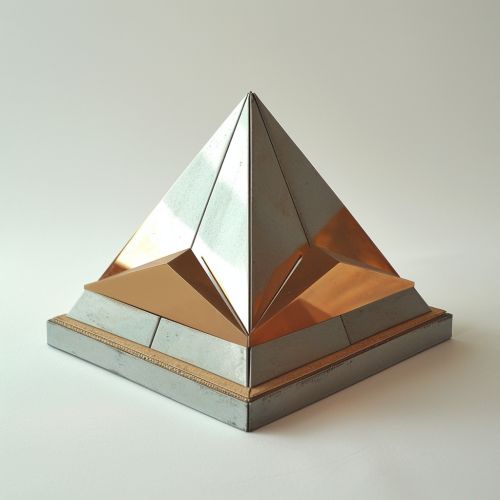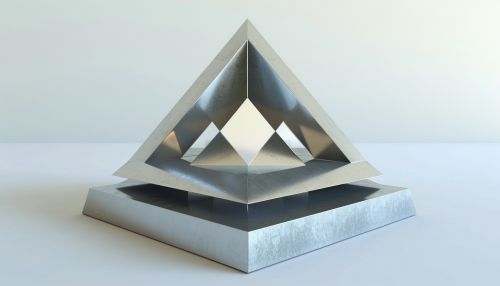Pyramid (geometry)
Introduction
A pyramid in geometry is a three-dimensional solid formed by connecting a polygonal base to a point, called the apex, by line segments from each vertex of the base. The base can be any polygon, but the most commonly known pyramid in the real world is the square pyramid, like the Great Pyramid of Giza.


Definition
Formally, a pyramid is defined as a polyhedron with a polygonal base and triangular faces that converge to a single point. This point is known as the apex or vertex of the pyramid. The base of the pyramid is a polygon of any type, and the pyramid is named after the shape of its base. For example, a pyramid with a square base is called a square pyramid, while a pyramid with a triangular base is called a tetrahedron.
Elements of a Pyramid
A pyramid has several key elements, including the base, faces, edges, and apex.
Base
The base of a pyramid is a polygon. The number of sides this polygon has determines the type of pyramid. For example, a pyramid with a triangular base is a tetrahedron, a pyramid with a square base is a square pyramid, and so on. The base can be regular (all sides and angles are equal), or irregular.
Faces
The faces of a pyramid are the triangular regions that connect the base to the apex. Each face is a triangle with one edge being a side of the base and the other two edges meeting at the apex. The number of faces a pyramid has is equal to the number of sides on its base plus one (for the base itself).
Edges
The edges of a pyramid are the line segments where two faces meet. A pyramid has twice as many edges as it has faces (excluding the base). Each edge is shared by two faces.
Apex
The apex, or vertex, of a pyramid is the point where all the triangular faces meet. It is the 'tip' of the pyramid and is opposite the base.
Types of Pyramids
Pyramids can be categorized based on the shape of their base and whether their apex is directly above the centroid of the base.
Regular Pyramids
A regular pyramid is a pyramid whose base is a regular polygon and whose apex is directly above the centroid of the base. All the faces of a regular pyramid are congruent isosceles triangles.
Tetrahedron
A tetrahedron is a pyramid with a triangular base. It is the simplest type of pyramid and is the only one with four faces, all of which are equilateral triangles.
Square Pyramid
A square pyramid is a pyramid with a square base. It has five faces: the square base and four triangular faces. The faces are all isosceles triangles in a regular square pyramid.
Irregular Pyramids
An irregular pyramid is a pyramid whose base is an irregular polygon or whose apex is not directly above the centroid of the base. The faces of an irregular pyramid are not congruent.
Properties of Pyramids
Pyramids have several interesting properties related to their geometry.
Volume
The volume V of a pyramid is given by the formula V = 1/3 * B * h, where B is the area of the base and h is the height of the pyramid. This formula is derived from the more general formula for the volume of a cone.
Surface Area
The surface area A of a pyramid is given by the formula A = B + 1/2 * P * s, where B is the area of the base, P is the perimeter of the base, and s is the slant height of the pyramid.
Euler's Theorem
According to Euler's polyhedron formula, for any pyramid, the number of vertices (V) plus the number of faces (F) equals the number of edges (E) plus two. That is, V + F = E + 2.
Applications of Pyramids in Real Life
Pyramids have been used in architecture and design for thousands of years. The most famous examples are the pyramids of Egypt, which were built as tombs for the pharaohs. Pyramids are also used in modern architecture, such as the Louvre Pyramid in Paris, which serves as the main entrance to the Louvre Museum.
In addition, pyramids have applications in various fields of science and engineering. For example, in computer graphics, objects are often modeled as a mesh of pyramids (or more generally, triangles). In physics, pyramids can be used to model the shape of certain types of crystals.
